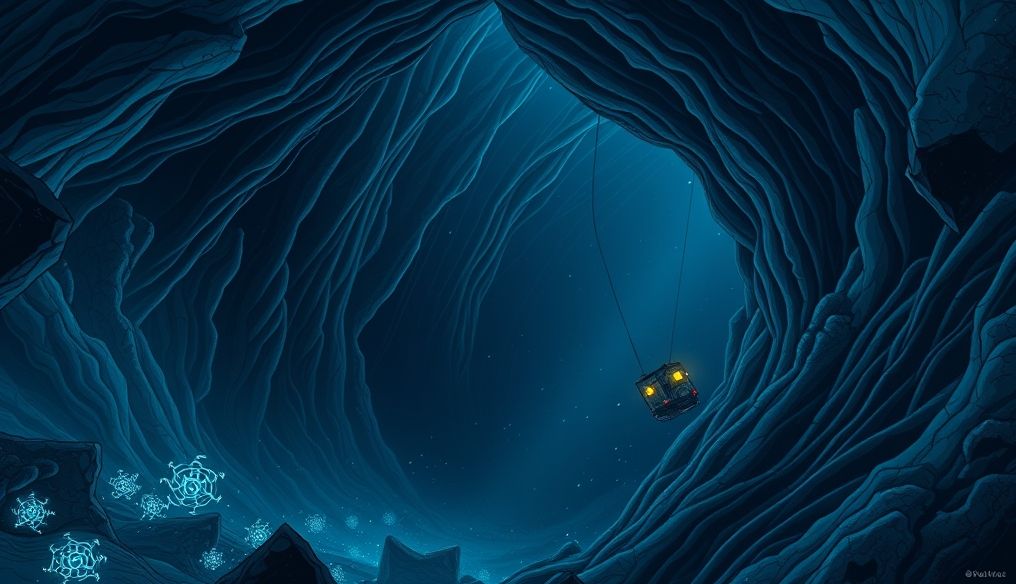What is the Mariana Trench?
The Mariana Trench is the deepest known part of the world's oceans. It is located in the western Pacific Ocean, east of the Northern Mariana Islands. Its depth reaches approximately 11 kilometers (36,070 feet) at its deepest point, known as the "Challenger Deep".
Where Exactly is the Mariana Trench Located?
The trench is located in the western Pacific Ocean near the Mariana Islands. Its shape is a long, narrow crescent. The trench extends for approximately 2,550 kilometers (1,580 miles) and is about 69 kilometers (43 miles) wide.
How Did the Mariana Trench Form?
The Mariana Trench was formed by a tectonic process called "subduction." Subduction occurs when one tectonic plate slides beneath another. In this case, the Pacific Plate slid beneath the Mariana Plate, leading to the formation of the trench.
What Forces Contributed to Its Formation?
The main force is the force of gravity pulling the Pacific Plate downwards. In addition, internal pressures within the Earth play a role in the formation of the trench.
Challenger Deep: The Deepest Point in the Trench
Challenger Deep is the deepest known point in the Mariana Trench, and therefore the deepest point in the world's oceans. Its depth was first measured by the HMS Challenger in 1875. Since then, many other measurements have been taken, confirming that the depth ranges between 10,900 and 11,000 meters.
Why is it Named Challenger Deep?
Challenger Deep is named after the British survey ship HMS Challenger, which conducted the first large-scale scientific survey of the oceans in the 1870s.
The Harsh Conditions in the Depths of the Trench
The depths of the Mariana Trench are characterized by extremely harsh conditions that make life very difficult. These conditions include:
- Immense Pressure: The pressure in the Challenger Deep is more than 1,000 times the atmospheric pressure at sea level.
- Complete Darkness: Sunlight does not reach these depths, making it completely dark.
- Low Temperatures: The temperature at the bottom of the trench ranges between 1 and 4 degrees Celsius.
How Do Living Organisms Adapt to These Conditions?
Living organisms in the Mariana Trench have developed unique adaptations to survive in these harsh conditions. These adaptations include:
- Ability to Withstand Immense Pressure: Some organisms have flexible bodies or strong skeletons that can withstand the immense pressure.
- Reliance on Alternative Energy Sources: Due to the absence of sunlight, organisms in the Mariana Trench rely on other energy sources, such as feeding on organic matter falling from above or feeding on other living organisms.
- Extreme Sensitivity to Touch: Due to the complete darkness, organisms in the Mariana Trench rely on their sense of touch to find food and navigate.
Living Organisms in the Mariana Trench
Despite the harsh conditions, the Mariana Trench is home to a diverse range of living organisms, including:
- Invertebrates: Such as amphipods, crustaceans, and annelid worms.
- Fish: Such as the Mariana snailfish, a small fish that can withstand the immense pressure at the bottom of the trench.
- Bacteria: Bacteria play an important role in the ecosystem of the Mariana Trench, breaking down organic matter and providing food for other living organisms.
Recent Discoveries in the World of Living Organisms There
Discoveries continue in the Mariana Trench, with new species of living organisms being found constantly. Recent studies have shown that the biodiversity in the Mariana Trench is greater than previously thought.
Human Exploration of the Mariana Trench
Despite the difficulty of reaching it, the Mariana Trench has been explored several times by submarines and remotely operated vehicles. These explorations include:
- 1960: Jacques Piccard and Don Walsh made the first human dive to Challenger Deep aboard the Trieste submarine.
- 2012: Filmmaker James Cameron made a solo dive to Challenger Deep aboard the Deepsea Challenger submarine.
- 2020: Kathy Sullivan, an oceanographer and former astronaut, dove to Challenger Deep, becoming the first woman to reach the deepest point in the oceans.
What Challenges Do Explorers Face?
The main challenges facing explorers in the Mariana Trench include:
- Immense Pressure: Building submarines and vehicles that can withstand the immense pressure at the bottom of the trench requires advanced and expensive technology.
- Complete Darkness: The complete darkness makes it difficult to see and explore the surrounding environment.
- Great Distance: Reaching the Mariana Trench takes a long time and is expensive.
The Scientific Importance of the Mariana Trench
The Mariana Trench is of great scientific importance because it provides a unique opportunity to study:
- Life in Extreme Conditions: Studying the living organisms in the Mariana Trench can help scientists understand how life adapts to and evolves in extreme conditions.
- Geological Processes: Studying the Mariana Trench can help scientists understand the geological processes that occur in the deep ocean, such as subduction and volcano formation.
- The Impact of Human Pollution: Studying the Mariana Trench can help scientists understand the impact of human pollution on the deep ocean.
What Research is Currently Underway?
Many studies are currently underway in the Mariana Trench, including studying biodiversity, geological processes, and the impact of human pollution.
Pollution in the Mariana Trench: A Hidden Threat
Despite its remoteness and depth, the Mariana Trench is not immune to human pollution. Plastic materials and other pollutants have been found at the bottom of the trench, posing a threat to marine life.
What are the Sources of Pollution?
Sources of pollution in the Mariana Trench include:
- Plastic Waste: Plastic waste leaks from various sources, such as ships and coastal cities, and settles at the bottom of the trench.
- Chemical Pollutants: Chemical pollutants, such as pesticides and heavy metals, leak from various sources and settle at the bottom of the trench.
How Does Pollution Affect Marine Life?
Pollution can affect marine life in the Mariana Trench in several ways, including:
- Poisoning: Pollutants can poison living organisms.
- Hormonal Disruptions: Pollutants can cause hormonal disruptions in living organisms.
- Bioaccumulation: Pollutants can accumulate in the bodies of living organisms and transfer to other living organisms in the food chain.
The Future of Mariana Trench Exploration
Exploration of the Mariana Trench is expected to continue in the future, with the development of new technologies that allow scientists to explore these abyssal depths more effectively. These future explorations may reveal more secrets about life in extreme conditions and the geological processes that occur in the deep ocean.
What are the Potential Future Technologies?
Potential future technologies for exploring the Mariana Trench include:
- Autonomous Submarines: Autonomous submarines can allow scientists to explore the trench for longer periods and at a lower cost.
- Advanced Sensors: Advanced sensors can allow scientists to collect more detailed data about the environmental conditions in the trench.
- 3D Imaging Technologies: 3D imaging technologies can allow scientists to create detailed maps of the trench floor.
The Mariana Trench, another world waiting to reveal more of its secrets.




